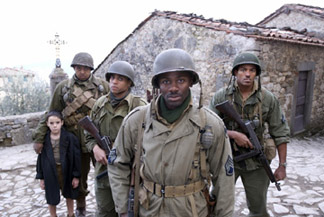|
|
Movie Review: Miracle at St. AnnaBy Matthew HuntleyOctober 6, 2008
As the four men prepare for a NAZI invasion (this late in the war, the German SS was retreating northwards), they meet a group of local villagers, among them the beautiful Renata (Valentina Cervi) and her Fascist father (Omero Antonutti). Renata, who speaks fluent English, tells them she's been waiting two years for her husband to come home, but her values shift when Stamps and Cummings show her signs of attraction. The movie bounces back and forth between the black soldiers and the higher-ranking white men, some of whom support the 92nd Division and others who don't. After a while, too much time is spent between both groups and the narrative starts to go in circles. I grew impatient and even a little bored. It was only during a brutal massacre scene, told in flashback by an Italian partisan (Pierfrancesco Favino), that rekindled my interest. Earlier, when I commented on violence that stands out, this is what I meant. I'm sure the script for Miracle at St. Anna read emotionally on paper, but I grew exhausted during the screening. I know this is an important story, but it's not told in a compelling or energetic way, which is a surprise since most of Spike Lee's movies contain a greater sense of urgency than most. The acting was sometimes weak and over-the-top, almost to the point where it became melodramatic and cartoonish. One of these instances happens early on, when the reporter and police are searching Negron's apartment. Notice how the detectives try to act tough; it's almost laughable. As is the ending on the beach, when we finally discover what the "miracle" is. The soldiers themselves feel like stock movie characters: the straight, always serious one; the selfish, womanizing con artist with an attitude; the loner; and the big-hearted teddy bear. None of these men are particularly interesting, though Miller does give a good performance as the "Chocolate Giant," probably because he fit the role so well. Terence Blanchard's score is the most distracting element of all. Yes, it would be a pleasure to listen to it in a different context, but here it plays through the entire feature, with no break and it doesn't always mix well with the mood of the scene. Rather than advancing the drama or complementing it, it took me out of it and made me lose focus of the characters. I admire Lee for wanting to put a spin on the traditional war picture, by including humor and showing multiple conflicts at once, but they don't thread well. That's not to say they couldn't, they just don't here. It's true that too few war pictures have made an effort to recognize the roles of African Americans, but this is not the one that will finally do them justice.
|

|
|
|

|
Thursday, October 31, 2024
© 2024 Box Office Prophets, a division of One Of Us, Inc.


